Military Personnel Overhaul
WaPo — Career Federal Worker Tapped To Oversee Pay, Personnel Overhaul At Defense
A longtime career federal employee, Mary E. Lacey, has been named to run the office that will develop plans to overhaul the civil service pay and personnel system at the Defense Department, the Pentagon announced yesterday.
Lacey was named program executive officer for the new National Security Personnel System and will report to Navy Secretary Gordon England. Lacey had served as technical director of the Naval Surface Warfare Center, which oversees weapons and systems testing, research and development at six major divisions.
***
Congress authorized creation of a new personnel system for the 746,000 civil service employees in the Defense Department last year — one of the biggest workplace changes inside the government in decades.
The Pentagon, however, got off on the wrong foot with some members of Congress, OPM and some labor leaders when some Defense officials created the impression that they were rushing the launch of the system.
After Defense Secretary Donald H. Rumsfeld selected England to oversee the process, the Navy secretary put it into slow gear, saying he intended to approach the personnel overhaul as he would the development of a large, complex weapons system.
Lacey, as head of the NSPS project office, will oversee teams that will work on an array of personnel issues, such as compensation, employee appeals of discipline and the bargaining rights afforded unions.
Although no decisions have been made, the new system seems likely to shift Defense employees out of the 15-grade General Schedule and into new pay categories that more rigorously link pay raises to a worker’s job performance ratings.
Why the SecNav is overseeing a DoD-wide mission is entirely unclear to me. The Under Secretary of Defense for Personnel and Readiness would seem the more logical choice.
The rationale for this overhaul is likewise unclear. As I’ve noted in a different context, DoD civilian employees are paid far less than their uniformed rank equivalent counterparts. The 15-step GS schedule is well established and reasonably flexible. Further, the civil service career system is aligned across government agencies so any restructuring of the DoD system–since it’s the largest employer–is going to create an imbalance elsewhere.
In related news: San Diego Union-Tribune — Conversion Of Military Jobs Set To Boost Front And Bottom Lines
In a manpower shell game, the Pentagon plans to hire more civilians and contractors to do jobs currently done by uniformed soldiers so more than 20,000 troops can be freed up for combat duty in coming years.
It’s part of an effort that began last year to bolster the number of front-line troops without adding more people to the ranks. Within a decade, it could involve 300,000 more troops, including the 20,070 positions being shifted to front-line roles by October 2005.
Unlike the civilian contractors driving fuel tankers to Baghdad, Iraq, or guarding Iraq administrator L. Paul Bremer, these new civilian jobs will be permanent and at stateside bases.
Already, hundreds of civilians have replaced sailors aboard a Navy flagship based in San Diego and, next year, jobs at area military hospitals and clinics and Marine bases could change over, officials said.
With only about three of every 10 troops in fighting roles, the 1.4 million-strong U.S. military has been hard-pressed to keep 138,000 troops on duty in Iraq.
Although more than 660,000 civilians work for the Pentagon, officers and enlisted personnel still do many noncombat jobs.
While some key decisions are weeks and months away, the conversion of military jobs to civilian positions may affect who orders Army supplies, treats children at Navy hospitals or hands out base passes at Marine Corps bases. Administrative, supply, medical and maintenance positions are likely targets for conversion, officials said.
While I’ve opposed the heavy reliance on contractors for missions in a combat zone, especially those involving direct combat or quasi-combat operations, this move seems logical enough. The DoD has for years been converting uniformed jobs in the service support arena to civilian, whether civil servants or contractors. There’s little downside to this move, as these folks tend to work for somewhat lower wages, have radically less generous benefits packages, and are much easier to get rid of as needs change.




Within the DoD portion of the Intelligence Community, the National Geospatial-Intelligence Agency already uses a “pay band” system (five levels, plus executives) and DIA is, I believe, starting to implement something similar. It reduces pay transparency a bit, but gives managers more flexibility in setting pay and handling assignments, as I understand it.
Congressional agencies and GAO do something similar. I’m not sure how it works in practice.
One thing that would seem an obvious problem in doing that with DoD is the issue of rank equivalency, which is important in such a hierarchical system. If you have a pay band so wide that it encompasses everything from CPT to LTC, then it’s problematic.
I agree, James. NGA basically uses Band 5 for GS-15, Band 4 for GS-13/14, Band 3 for GS-11/12, and then I’m not sure (my friends and associates are in the top three bands)…I think only the GS-7s and up (“officer grades”, more or less) are in the “Band” system at all, so that would imply GS-7/8 are Band 1 and GS-9/10 are Band 2…
I think the clerks, etc., are handled separately, using the “standard” General Schedule.
I’ve always had a problem with civilians considering themselves “equivalent” to military ranks. Obviously, you should use the civilian’s grade to determine billeting and dining requirements, but waaaaay too many have taken it much further than that.
I don’t care if you’re a GS-15 or a GS-7: you’ve got no military standing, and it doesn’t benefit anyone for you to act as though you’re some sort of officer.
“If I were on active duty…” “Yeah, well, you’re not, so shut up.”
Boyd,
The problem with that is that DoD civilians are often in the chain of command, actually rating military personnel. As a supervisory GS-12, my dad was the primary rater for a major and several captains and the senior rater for many NCOs. He as also a retired E-8.
My current boss is a GS-15 and she’s an 0-6 equivalent. She rates several LTCs and MAJs.
I understand that it happens that way, James. I just don’t think it should.
—